How Government Destroyed Science in Columbia River Dam Decisionmaking
News from the Front #95
Remarks at the First Annual Northwest Water Law Symposium, Lewis & Clark Law School, January 31, 2009 (edited)
By James Buchal, author The Great Salmon Hoax [here]
Before I begin discussing the use of science in Columbia River decisionmaking, I think it is important to have a definition of what science is, and I am going to choose a definition that will make it clear that science is not really used at all any more.
What is science? Since this is a law school, I will cite the Supreme Court’s Daubert case, which determined how federal courts should decide whether to accept scientific expert testimony. In that case, the Court actually managed at one point to stumble right on it:
Scientific methodology today is based on generating hypotheses and testing them to see if they can be falsified; indeed, this methodology is what distinguishes science from other fields of human inquiry.
I will argue that the essence of science is that there are things that are out there that are true, and while we can all speculate about the truth is, we can test our speculation against the truth. This is usually done by taking measurements in an experiment. And when our hypothesis is falsified, that is, contrary to the truth as revealed by the evidence we gather, we have to discard or refine that hypothesis.
I would also argue that measurement or quantification is another very important aspect of science. As a famous physicist, Lord Kelvin once observed,
When you can measure what you are speaking about, and express it in numbers, you know something about it; but when you cannot measure it, when you cannot express it in numbers, your knowledge is of a meager and unsatisfactory kind: it may be the beginning of knowledge, but you have scarcely, in your thoughts, advanced to the stage of science.
What Lord Kelvin did not say is that if you really have a scientific understanding of something, you can also use that scientific knowledge to predict what will happen under a certain set of initial conditions (at least outside the quantum context).
Since this is a law school, you might think that the courts are on the job policing the matter and making sure governmental policy has some relationship to science. Unfortunately, that is false. There are a number of what I would call vectors of decay in modern law that decisively falsify that idea.
1. Federal courts will not decide the truth in scientific questions. Indeed, they are fundamentally disinterested in whether government decisions are true or not; the standard of review is “arbitrary and capricious,” not right or wrong. A corollary of the this rule, by the way, is that the Daubert test for reliability of expert scientific evidence is completely inapplicable in the context of judicial review of agency action.
2. Federal courts will not require the government to release its files containing scientific information if the government wants to keep them secret. The Federal courts have invented a presumption that the quality of administrative decisionmaking will be improved if citizens are not able to see anything going on during the decisionmaking process, which might “chill” the process or “embarrass” the participants.
3. Federal courts will not permit people who disagree with government science and file law suits about it to get any discovery of the scientists involved, or their papers. As a practical matter, judicial review is limited to the record that the government gets to assemble to justify whatever decision it has made. And so if something doesn’t help, and the Justice Department has assigned what we might call effective lawyers to the case, well, they just leave it out of the record.
4. Federal courts will not even permit people who disagree with the government decisions to question to the government’s scientific witnesses in court, even when they rely on their affidavit testimony to make decisions. Cross-examination has been called the greatest engine for the discovery of truth ever invented, but it is almost never used in cases concerning government scientists.
So other than the occasional activist judge who ignores administrative law, the judicial branch has abandoned any effort to discern scientific truth. Indeed, one usually hears a pitiful sort of whining from the judges along the lines of “it’s not my job” or “it’s too hard”.
So we are left with the integrity of the individual scientists themselves. How is that working for us? Unfortunately, it is a very rare kind of integrity that is required; it takes real open-mindedness to hold a hypothesis, and when it has been falsified, to modify or discard the hypothesis, and try again. People who call themselves scientists often pretend to have this openmindedness, but they are just people after all, and those who have studied the history of science can see that nearly all scientists can’t achieve this state of mind.
Our other panelist, Dr. Haeseker, just suggested that a test of “endurance” for scientific truth, but falsity is pretty durable too. Michael Crichton gave a horrible example in a speech a few years ago at Caltech:
In past centuries, the greatest killer of women was fever following childbirth . One woman in six died of this fever. In 1795, Alexander Gordon of Aberdeen suggested that the fevers were infectious processes, and he was able to cure them. The consensus said no. In 1843, Oliver Wendell Holmes claimed puerperal fever was contagious, and presented compelling evidence. The consensus said no. In 1849, Semmelweiss demonstrated that sanitary techniques virtually eliminated puerperal fever in hospitals under his management. The consensus said he was a Jew, ignored him, and dismissed him from his post. There was in fact no agreement on puerperal fever until the start of the twentieth century. Thus the consensus took one hundred and twenty five years to arrive at the right conclusion despite the efforts of the prominent “skeptics” around the world, skeptics who were demeaned and ignored. And despite the constant ongoing deaths of women.
And we can see this thing over and over in science: most of the scientists just don’t care enough about the truth to listen to a minority, or a single skeptic, who has good evidence inconsistent with what they believe.
People like to believe what everyone else around them believes, even if is plainly wrong. Indeed, consensus is the enemy of science, because consensus is invoked to maintain the conventional view. And maintaining the conventional view means we do not advance our understanding. So when you hear politicians say they are ensuring good science through peer review, it is a lie like nearly everything else politicians say, because peer review is the enforcement of consensus.
Just to try and liven things up here, I’d like to give an example, that Dr. Haeseker has just talked about. You may recall he showed a slide with some people in a inner tube drinking beer and floating down the river. And he said that because of the dams, the Lower Granite to Bonneville float time, which he equated with fish travel time, has gone from 1.7 days to 18.7 days. But it is easy to falsify the hypothesis that within the wide range of river flows we observe now, that fish travel time changes much at all.
Now it is a basic fact about the Columbia River that its flow varies widely from year to year. Here is a chart of Columbia River flows in the last decade, and I will call your attention to the blue line at the bottom which represents the low flows of 2001, and you can see that in many years, the River’s flow is nearly triple this year.
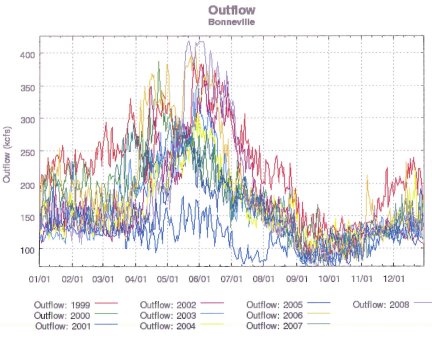
Now all of these variations in flow generate a lot of data. And early on, scientists tried to measure salmon survival, and back in the 1970s, some of them noticed that salmon seemed to survive better in years of higher flow.
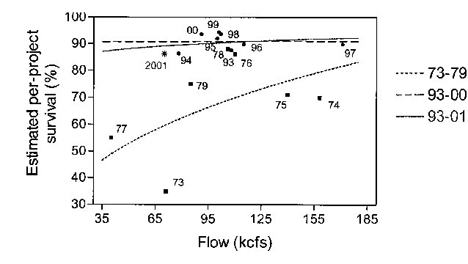
And you can see that during the 1970s, when they first gathered the data, there seemed to be a relationship between river flow and salmon survival. Now later on, it turned out that there was something wrong with these two data points (1973 and 1977), and the data got a lot flatter, even in 2001, but we don’t have time to go into that.
The important point is that from these fairly rudimentary observations, an enduring policy prescription has emerged for helping salmon. It’s a simple syllogism really: (1) we can move the river faster, (2) that moves the salmon faster, and (3) if they move faster, they spend less time in the reservoir death zone and their survival will be higher.
Each of these statements can be tested for truth. Starting with the third one, by 1993, when the first accurate measurements of salmon survival in reservoirs were obtained, the results were so utterly contrary to the death zone theory that the experiments had to be done over and over and over and over again before biologists would believe them. The reservoirs were not death zones at all. Young salmon die at higher rates both above the dams and below them.
But this had absolutely no effect on salmon policy. You have probably heard the old expression there are lies, damned lies, and statistics. The modern version of that probably ought to go: there are lies, there are damned lies, there are statistics, and then . . . there are computer models. And we began to see what has become an epidemic of fraudulent computer models on this issue and many others.
Now fraud is a serious charge, and I do not make it lightly. One important feature of computer models is what factors are taken into consideration in the model. Here is a graph of salmon survival versus flow over hundreds of observations.
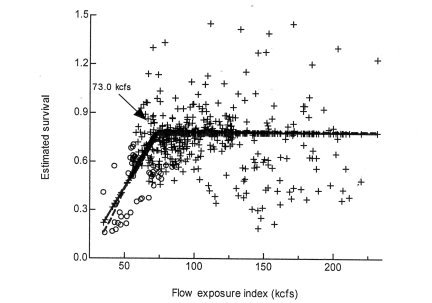
If I may digress again, imagine that salmon scientists were engineers selling you a car, and if we press on the accelerator (analogizing to more flow), this haze of dots would represent that with this salmon engineer car, sometimes it goes backwards, and sometimes forwards.
What I want to focus on is these few points down here with low flow and low survival. They all are represented by circles, and all come from the low flow year of 2001. And they all have one thing in common: high river temperatures. And young salmon die a lot more rapidly with higher river temperatures, because the things in the river are cold blooded things, and when the water warms up, they get hungrier and eat more salmon.
But if you build computer models, and just leave temperature out of them, you can take the effects that arise from temperature, and pretend that they arise from flow. So some scientists built models with temperature, and some without. Models with temperature have an interesting characteristic: they actually fit reality; they have predictive power. Here for example is a model developed by Professor Anderson, who labored in this field for about a decade, figured it out, published his model.
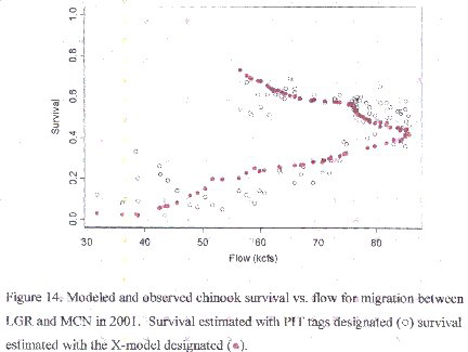
The model was ignored, just like Oliver Wendell Holmes and all the other doctors, and Dr. Anderson has moved on on to other things, but it is a remarkable achievement.
Models that just use flow have a harder time, since there is very little correlation between flow and survival. The cloud of dots slide I just showed you pretty much proves that; here is some additional data disaggregated by year, and you can see sometimes flow is positively associated with survival, and sometimes negatively associated.
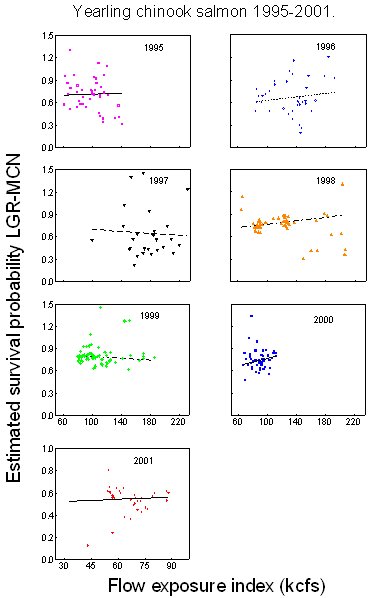
So no matter what kind of model we run this data through, there is really nothing there.
Now let’s look at another premise of the “more flow” theory: we can make fish move down the river faster by making the river move faster. Nature runs that experiment for us every year with natural flow variations, and the remarkable thing is that over enormous flow variations, the fish tend to arrive down at the bottom of the river at the same time every year.
Here is a chart that the State of Oregon prepared last month to try and explain their flow theory:
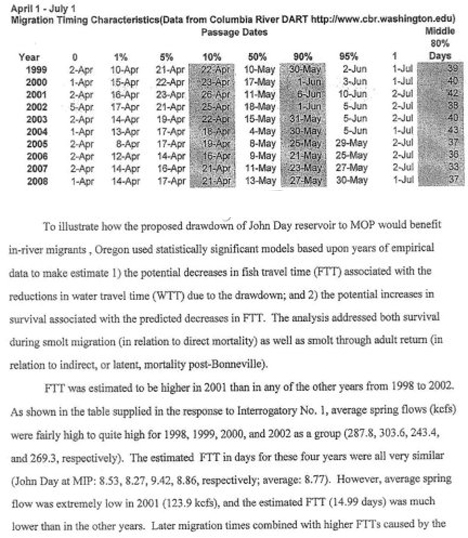
The 50% column represents the date half the fish get to the bottom of the River. You can see that in the year 2001, with less than half the flow of most years, the fish were only about 0.6 days later (the median passage date). Yet on the very same page, Oregon is pointing out that its models show an estimated fish travel time (FTT) from its computer models showing fish should have taken almost twice as long to get there in 2001. Clearly, fish are nothing like people floating in inner tubes, drinking beer, contrary to Dr. Haeseker’s presentation.
Over the years I have seen the government scientists use fudge factors with negative survival to try and make their models fit the actual data. By now, though, the whole idea of testing the models against reality just got shoved under the rug. Policy is made by having the person with the most power hold up something they call science, whether or not it fits reality. And the disconnect between reality and policy grows stronger and stronger.
I want to speculate a little bit about how so many people can be so blind, and I think the root of the problem, like the root of so many other public problems, is the federal government. You may have heard that our federal government is a government of limited powers, but that is no longer true, because the same federal courts that refuse to address the problem of truth in government decisionmaking also decided, notwithstanding that quaint idea of a Constitution, that the federal government has the powers to (1) print paper money; and (2) spend that paper on whatever it wants.
And after WWII, the Cold Warriors decided, that “science is the responsibility of government because new scientific knowledge vitally affects our health, our jobs, and our national security”. And so rivers of federal money flowed out of Washington, a mighty army of federally-funded scientists has arisen to get that money.
One version of the Golden Rule, the non-Biblical one, is that he who has the gold, rules. And that is true in science. When those in charge of the purse strings are funding science, they can shape that science to support their political positions.
This is not just a problem with salmon science; there is a lot of literature in the area of medical research, for example, showing how NIH committees wind up funding the same wrong ideas over and over and over again.
And the people involved just seem to lose their capacity to discern scientific truth. Again, this is not a particularly unusual phenomenon. Upton Sinclair once remarked: “It is difficult to get a man to understand something when his salary depends on his not understanding it.” And here in the Northwest, we have literally billions of dollars in salaries going out to an army of scientists who just can’t seem to understand ecological problems and solve them, because if they understood them, they’d have to find new work.
And there is really only one antidote for this. We have to recover their ability to distinguish between facts and opinions. When people stand up in front of you like Dr. Haesker, and wave a bottle of vodka and a hot dog around to show how big the fish tags were in Dr. Welch’s study [presented by a previous panelist, John McKern], this is not science. This is an attempt to distract you from the science. Because Dr. Welch compared fish in the Columbia (eight dams) and the Fraser (no dams) that had the same size tags. Even if the tags are so big that some fish die, the Columbia River fish are still enjoying higher survival than the Fraser fish, which calls into question the whole idea that the dams are hurting the fish, an idea that pays Dr. Haeseker’s salary and the salaries of thousands of others.
Years ago, Thomas Jefferson said: “The general spread of the light of science has already laid open to every view the palpable truth, that the mass of mankind has not been born with saddles on their back, nor a favored few, booted and spurred, ready to ride them.” You all are going to have to work a lot harder to figure out what the truth is, and hold your leaders to pursue things that are true, or your future is going to get darker and darker because the light of science is not spreading any more. It is dimming.
***
Postscript: The presentation was not a success. Though Dr. Haeseker had called Dr. Welch’s research “shameful”, and moved another panelist to describe his presentation as a violation of American Fisheries Society and federal ethical standards, most of the students just nodded numbly for him. I was regarded as not operating in the “reality-based community”. Of course fish need more water. With that, the proceedings moved on to a presentation by Gore acolyte Bill Bradbury on the threat of climate change, a highly-polished presentation that carefully omits any proof whatsoever that anything that mankind does has any measurable effect on the climate.
You have permission to reprint this
article, and are encouraged to do so. The sooner
people figure out what’s going on, the quicker
we’ll have more fish in the rivers.
Other Salmon Materials [here]
by John M.
